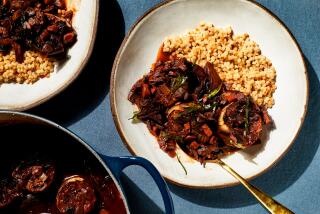In Search of the Skinniest Eggplant
- Share via
Over the years I have experimented with low-fat ways to prepare eggplant, and I was delighted by the result when I sauteed the eggplant in a small amount of oil, then covered the pan and continued cooking it with the steam it produced.
Recently I’ve discovered that eggplant can be delicious when braised without oil. I simply brown an onion by cooking it with a tablespoon or two of vegetable broth, add the eggplant and some tomato sauce and cook them in a covered pan. If the pan becomes dry in the course of cooking, I add more broth, a tablespoon or two at a time. The eggplant comes out tender and tasty, and the oil isn’t missed.
For extra flavor, I add chopped garlic at the same time as the tomato sauce. Occasionally I prepare a spicy rendition with cumin, turmeric and hot pepper, or an Asian variation with equal amounts of soy sauce and rice vinegar replacing the tomato sauce. I serve the eggplant sprinkled with chopped cilantro, parsley or chives, which enlivens the color and adds a great fresh flavor. Often I garnish the eggplant with roasted red peppers.
There is one requirement for this eggplant dish to be delicious. The eggplant itself should be fresh and smooth, not one that has been sitting at the back of the refrigerator for a week. I’ve had the best results with long, thin, pale lavender Chinese eggplants. The similarly shaped dark purple Japanese eggplants also are good.
Whether you’re trying to lose weight or simply trying to improve the nutrition of your family’s meals, this fat-free way of cooking eggplant will be a useful addition to your repertoire. It has several other advantages: It’s quick and easy, keeps in the refrigerator for several days and is as good cold as hot.
FAT-FREE EGGPLANT IN SAVORY TOMATO SAUCE
1 large onion, preferably sweet
1/2 cup vegetable broth or more
1 1/2 pounds Chinese, Japanese or small Italian eggplants, unpeeled, cut in rounds about 3/8-inch thick
Salt, optional
Freshly ground pepper
1 (8-ounce) can tomato sauce
3 large cloves garlic, chopped
1 large sprig thyme or 1/2 teaspoon dried
1 teaspoon cumin, optional
Coarsely chopped cilantro or parsley
The secret to this dish is how you brown the onion in the broth. You need patience to do this gradually, adding vegetable broth a little at a time when the pan becomes dry so the onion slowly browns but does not burn. Chinese eggplants cook faster than other varieties. I use broth that I save from cooking vegetables like carrots, zucchini, leeks and green beans, but canned vegetable broth can be used. If you use canned broth, taste the dish before adding any salt.
Halve onion lengthwise from top to bottom. Set cut-side down on board and cut each half into quarters.
Heat 1 tablespoon broth in large, nonstick skillet. Add onion and cook 2 minutes over medium-high heat, stirring, then 2 minutes over medium heat. Cover and cook, stirring and adding broth by tablespoonfuls as pan gets dry, until light brown, about 2 minutes more. Do not let onion burn.
Add eggplant slices and salt and pepper to taste and stir to coat eggplant with onion mixture. Cover and cook 2 minutes over medium heat. Add tomato sauce, 2 tablespoons broth, garlic, thyme and cumin. Stir gently. Cover and cook 5 minutes, stirring once or twice.
Add 1 or 2 tablespoons broth if necessary. Cover and cook over low heat until tender, 5 to 10 minutes. Discard thyme sprig. Taste and adjust seasoning. Sprinkle generously with cilantro and serve.
2 main-course or 4 side-dish servings. Each side-dish serving:
78 calories; 477 mg sodium; 0 cholesterol; 1 gram fat; 18 grams carbohydrates; 3 grams protein; 2.35 grams fiber.
More to Read
Eat your way across L.A.
Get our weekly Tasting Notes newsletter for reviews, news and more.
You may occasionally receive promotional content from the Los Angeles Times.









